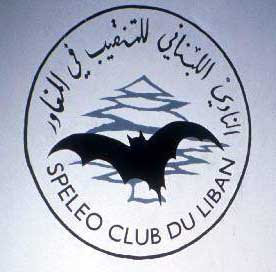 |
© 2005 by John and Susy Pint
Updated September, 2013
We were determined to remedy this situation and in June of 2002, three Saudi geologists plus John and Susy Pint flew to beautiful Beirut for a basic Cave Rescue course.
We stayed at the Bella Riva Hotel, just overlooking the beautiful blue Mediterranean. Only a few steps away, there was a long Corniche where hundreds of people love to go walking in the cool of the evening. Here you could see Muslims and Christians, men and women strolling together and it gave us a glimmer of hope that maybe the rest of the world might someday learn to live and work together in harmony as the Lebanese seem to be doing.
Our friends at the Speleo Club du Liban kept us jumping day after day with a heavy schedule:
|
...and we had ample opportunities to try out a variety of approaches to ascending, rappeling and even the use of carbide for lighting.
|
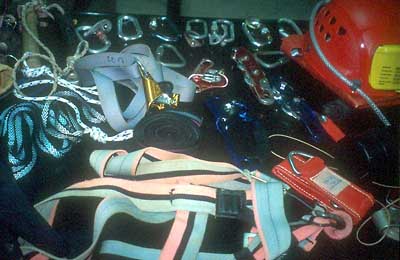
|
|
At the same time, we practiced climbing up and down ropes and cable ladders at the club headquarters.
|
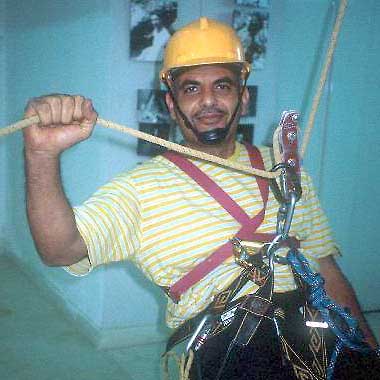
|
All of this training came together nicely on Sunday when we drove out to cold, wet Rouaisse Cave, located 'way up in the mountains, for a simulated Cave Rescue.
Ah, the mountains of Lebanon! Peaks of sharp limestone rising through the pine trees, bright yellow "broom" perfuming the air and narrow, twisting roads overhanging sheer cliffs.
A dirt road took us to the entrance of the cave. As we arrived, two sonic booms exploded above us and we looked up. Two white streaks stretched across the sky. “Every day the Israelis fly over us and do this to remind us of their presence,” commented Sami Karkabi, Lebanon’s caving pioneer. Half the Speleo Club was out there changing into thermal underwear, coveralls and "Wellies" (long black, rubber boots). Soon we were organized into teams, each with its own captain and everyone under the command of one leader. We were reminded again and again that good organization is the key to a successful rescue and we were instructed to keep our mouths shut and be serious at all times.
Just getting our patient onto the specially constructed Cave Rescue Stretcher turned out to be a tricky job. Then we learned that "an earthquake" had just occurred and we would not be able to leave the way we came in. There was, of course, another way to exit the cave, but we would have to traverse...
THE PASSAGE FROM HELL
This fissure-like tunnel is mostly narrow with lots of knobs and sharp shelves poking at you from both sides. So, you squeeze your way along and every once in a while you come to a wide spot where you think "Ah, that's more like it," but then you discover you are dealing with a new problem, because these wide places are inevitably flooded with icy cold water and the only way to pass them without getting wet is to stretch your legs far apart and try to climb above the pools. Since we cavers from Saudi Arabia had no "Wellies," we did our best -- at first -- to keep our feet dry, which is no easy trick if you are short!
Well, somehow I succeeded and arrived dry shod at a lineup of maybe eight rescuers who were in the process of passing the stretcher along from person to person...
|
...We were "seated" alternately with our backs against one wall and our feet braced against the other, the idea being to slide the stretcher over our laps...
|
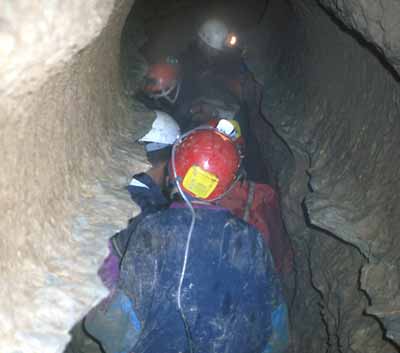
|
Now, all of us were perched on top of
pointy or knobby protrusions which
mercilessly pressed against our bottoms when the stretcher rested on
our knees.
Of course, this was even less of a joy ride for the “victim” as there
was
often not enough room for the stretcher to pass through right side up
and we’d
have to turn it sideways, just barely scraping by.
The
moment the stretcher had passed us, our team leader had us hurrying
through the
Passage from Hell in the opposite direction and then climbing up and
down heaps
of rocks and racing through other rooms in this maze of a cave, to end
up…yes,
you guessed it, once again back at the beginning of the same Diabolical
Passage!
...And
slip they did! “Saeed
was there
one minute,” said Mahmoud, “but I turned my head a second and when I
looked
back, he was gone.”
In
fact, bits of the wall above us were breaking off all the time and one
of our
tasks was to keep our hands cupped over the victim’s face at all times,
even
though they had put special plastic goggles on her. The importance of
this was
really brought home when a rock weighing half a kilo plopped down from
above
onto the victim’s stomach!
Once
again we passed the stretcher on to another group and raced around
through other
routes, back to the beginning of the Passage from Hell. One glance told
me my
position was going to be right at the one spot where the water was
nearly waist
high so -- goodbye dry feet -- I just plunged in.
HEAVENLY
SURPRISE
At
last we reached the point where we could see daylight ahead -- what a
relief! I figured the exercise we all
got in those few hours was equivalent to spending all day in a really
tough
cave. However, the coordinators pointed out that, because we people
from Saudi
Arabia hadn’t come prepared for wet caves, they had shortened the
planned
route considerably, limiting it to what they considered “dry” passages
and
leaving out an area where the freezing cold water is up to your neck.
The
Passage from Hell was, apparently, “heavenly” in comparison to the one
we
never saw! We exited the cave at 1 PM, but the longer route would have
taken us
another seven hours!
Besides Rouaisse Cave, I also had a chance to revisit Kanaan Cave which has flowstone floors as well as walls and is simply dripping with formations of all kinds. The Lebanese call this cave The Temple of Speleology and we had visited it briefly with Sami Karkabi on our first trip to Beirut, but we had had time only for a quick look and we left this magnificent cave with our tongues hanging out.
Of course, we couldn’t leave Beirut without a visit to famous Jeita Grotto, one of the world’s finest show caves. Now, the first time we visited it, we were with Paolo Forti and Bill Halliday who pointed out all sorts of details one needs to know about transforming wild caves into tourist caves. This time we were accompanied by geologist Jim Leanderson, who now teaches in Beirut and who has been doing a study of earthquake damage inside Jeita. Hopefully, techniques he is working on will help us learn more from the cracks and fallen speleothems in Saudi Caves.
|
|
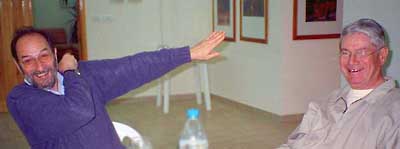
|
At the end of the week, we knew we had only scratched the surface of Cave Rescue and First Aid, but at least we have taken the first steps. With a new highway now creeping across the Summan karst, I suspect there will eventually be cries for help from people lost, stranded or hurt inside some dahl and we may be called upon to put these rescue techniques to work sooner than we think.
|
|
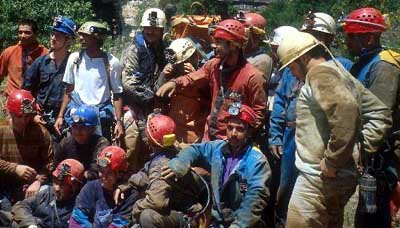
|
For our best photos of Lebanon, visit the TRIBUTE TO LEBANON Picture Gallery here on www.saudicaves.com
John and Susy Pint